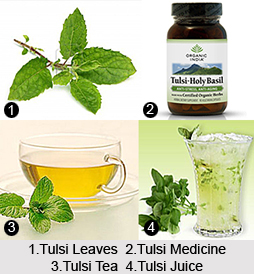 Tulsi or Holy basil is a sacred plant in Hindu religious tradition. It is worshipped by a large number of Hindus. In Hinduism, the worship of gods and goddesses is incomplete without the offering of Tulsi. Interestingly, this holy basil is also a herbal remedy for various ailments. Blood purifying, sharpening memory, purifying polluted water, to strengthening heart and digestive system Tulsi plant is the best remedy.
Tulsi or Holy basil is a sacred plant in Hindu religious tradition. It is worshipped by a large number of Hindus. In Hinduism, the worship of gods and goddesses is incomplete without the offering of Tulsi. Interestingly, this holy basil is also a herbal remedy for various ailments. Blood purifying, sharpening memory, purifying polluted water, to strengthening heart and digestive system Tulsi plant is the best remedy.
Usage of Tulsi in Various Treatments
•To improve memory swallow five leaves of Tulsi or crush eight leaves, four black pepper seeds, two almonds and a little honey.
•To purify polluted water, drop a few fresh green Tulsi leaves in it.
•Treat burns by smearing the affected part with coconut oil boiled with Tulsi juice. This will reduce pain and hasten the healing.
•Persistent thirst can be quenched by drinking the sherbet of tulsi leaves, sugar and lemon juice.
•To strengthen the heart daily ingest five leaves of Tulsi, three black pepper seeds and three almonds. Take it during winter season only.
•Boil saindhav salt with Tulsi juice, two drops will revive a fainted person.
•Regular use of Tulsi effects rapidly increase in the number of the red blood corpuscles.
•Cut the dried twigs of Tulsi into beads of the size of large pearls. String together the beads. Wearing protects one from infectious diseases.
•The leaves of tulsi are an ideal solution for the ulcer and infections in the mouth. A few leaves chewed will heal the problem.
•Swallowing five leaves of Tulsi every morning also protects one from infectious diseases.
•Tulsi leaf juice with sugar acts as a preventive from sunstroke.
•For fatigue drink an extract of Ram Tulsi leaves with cow`s milk and sugar.
•Tulsi is useful in the treatment of respiratory system disorder. A decoction of the leaves mixed with ginger and honey is an effective remedy for ailments like bronchitis, asthma, influenza, cough and cold.
•The juice of basil leaves and honey is extremely helpful in case of renal stone. If this juice is taken regularly for 6 months it will expel them via the urinary tract.



















